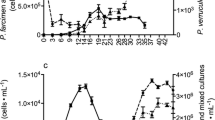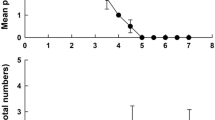Abstract
Results from experiments with the three species constituting the dominant tubificid community of eutrophic lakes in Scandinavia, i.e. Tubifex tubifex, Limnodrilus hoffmeisteri and Potamothrix hammoniensis, suggested the involvement of mutualistic mechanisms. Previously Wavre & Brinkhurst, 1971; Brinkhurst, 1974 and McMurtry et al., 1983, described phenomena of this kind within a North American species complex involving T. tubifex and L. hoffmeisteri, as well.
In mixed cultures, in comparison with monocultures of the respective species, I found that growth rate increased in the order of 50% and sexual maturity was reached earlier. Especially the three-species combinations rapidly increased in weight. Experiments with choice chambers, containing sediments enriched with the faecal pellets of each species alone or in species combinations, revealed specific reactions by the worms. As an average of three replicates, each starting with 45 recently hatched worms in equal proportions of the three species mentioned above, 14 chose the faeces of L. hoffmeisteri, 11 chose P. hammoniensis, 2 chose T. tubifex, 4 chose a combination of T. tubifex and L. hoffmeisteri and 4 chose blanks. Another 10 worms did not succeed in entering the choice chambers from the sandy substrate into which all worms were introduced and rapidly died off.
The results seem to support the hypothesis that increased growth rate achieved in mixed cultures is due to each species selectively grazing concentrations of bacteria associated with the faeces of another species in the community. Earlier findings have shown that each species characteristically tends to “cultivate” only one species-specific bacterial strain at a time in its intestines (Wavre & Brinkhurst, 1971).
Since the above species combination is by far the most frequently occurring oligochaete community in eutrophic lakes in Scandinavia and monocultures of any of the species involved are fairly uncommon under natural conditions, one may speculate that mixed cultures better utilize common available resources in accordance with experimental results.
Similar content being viewed by others
References
Brinkhurst, R. O., 1974. Factors mediating interspecific aggregation of tubificid oligochaetes. J. Fish. Res. Bd. Canada 31 (4): 460–462.
McMurtry, M. J., D. J. Rapport & K. E. Chua, 1983. Substrate selection by tubificid oligochaetes. Can. J. Fish. Aquat. Sci. 40: 1639–1646
Wavre, M. & R. O. Brinkhurst, 1971. Interactions between some tubificid oligochaetes and bacteria found in the sediments of Toronto Harbour, Ontario. J. Fish. Res. Bd. Canada 28: 335–341.
Author information
Authors and Affiliations
Rights and permissions
About this article
Cite this article
Milbrink, G. Mutualistic relationships between cohabiting tubificid species. Hydrobiologia 155, 193 (1987). https://doi.org/10.1007/BF00025650
Issue Date:
DOI: https://doi.org/10.1007/BF00025650




